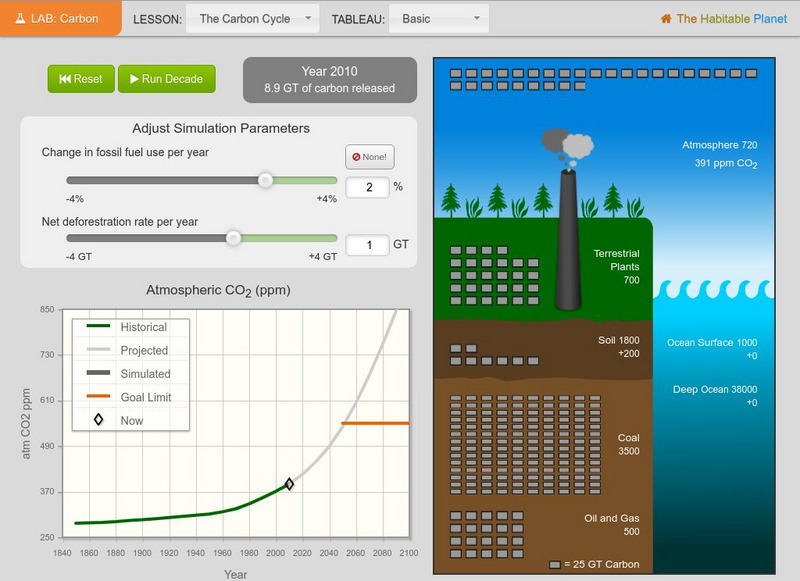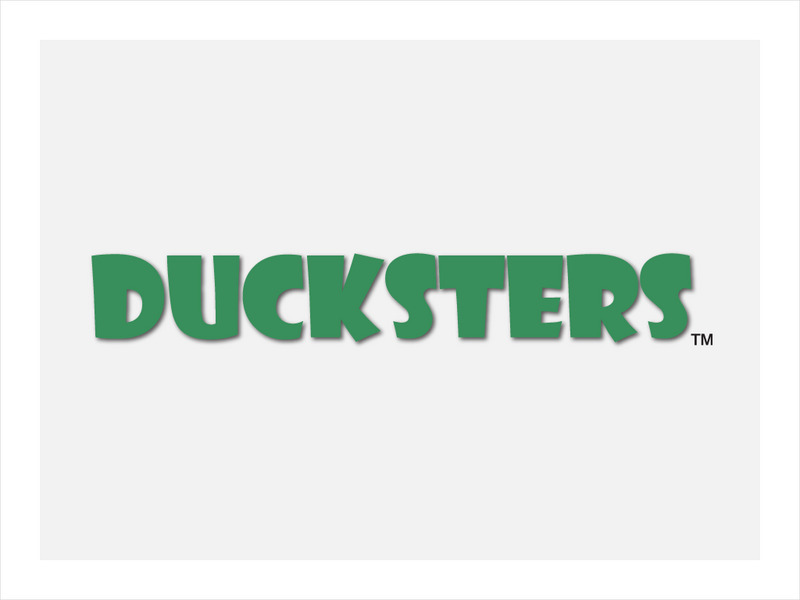Hi, what do you want to do?
National Earth Science Teachers Association
Windows to the Universe: Biogeochemical Cycles
Biogeochemical cycles happen when individual elements are recycled over and over in different parts of the Earth. Two examples are the Nitrogen Cycle and Carbon Cycle. Read an explanation of biogeochemical cycles and view a diagram of...
Annenberg Foundation
Annenberg Learner: Carbon Lab
This lab uses a robust model of the carbon cycle to give an intuitive sense for how carbon circulates through the atmosphere, biosphere, oceans, and crust.
Climate Literacy
Clean: Carbon Cycle Game
In this interactive, regionally-relevant carbon cycle game, students are challenged to understand the role of carbon in global climate change. They imagine that they are carbon molecules and travel via different processes through carbon...
Massachusetts Institute of Technology
Mit: Open Course Ware: Courses: Civil Environmental: Ecology I: The Earth System
College-level online course highlighting the fundamentals of ecology. Course topics include coevolution of the biosphere, geosphere, atmosphere, and hydrosphere; photosynthesis and respiration; and the carbon, nitrogen, and water cycles....
PBS
Pbs Learning Media: Global Warming: Carbon Dioxide and the Greenhouse Effect
This video segment adapted from NOVA/FRONTLINE demonstrates the physical property of carbon dioxide that causes the greenhouse effect. Includes background reading and discussion questions. [2:26]
CK-12 Foundation
Ck 12: Earth Science: Carbon Cycle and Climate
[Free Registration/Login may be required to access all resource tools.] How carbon circulates throughout the environment.
CK-12 Foundation
Ck 12: Earth Science: Carbon Cycle and Climate
[Free Registration/Login may be required to access all resource tools.] How carbon circulates throughout the environment.
Ducksters
Ducksters: Science for Kids: Carbon Cycle
Kids learn about the carbon cycle and how this nutrient travels through the ecosystem to sustain life on Earth.
American Geosciences Institute
American Geosciences Institute: Earth Science Week: Soil, Plants, and the Energy Cycle
Students explore what kind and how much bio-mass can be produced in an area around your city or town. They figure how many gallons of fuel can be expected from one acre of crop land, and how much carbon can be sequestered in the local area.
University Corporation for Atmospheric Research
Ucar: Project Learn: Where in the World Is Carbon Dioxide?
In this lesson on greenhouse gas, students conduct experiments to detect and collect carbon dioxide, then use titration to determine how much carbon dioxide is present in an indicator solution.
Center for Educational Technologies
Exploring the Environment: Global Climate Change
This tutorial looks at carbon dioxide in the atmosphere and how changes can impact wheat production in Kansas.
Other
Water on the Web
Water on the Web (WOW) is an advanced site allowing students to actively participate in data analysis from real research sites. Lesson plans on a range of topics are provided. There is also a tutorial for using Excel to graph WOW data.
TeachEngineering
Teach Engineering: Dinosaur Breath
Through discussion and hands-on experimentation, students learn about the geological (ancient) carbon cycle. They investigate the role of dinosaurs in the carbon cycle and the eventual storage of carbon in the form of chalk. Students...
TeachEngineering
Teach Engineering: Biorecycling: Using Nature to Make Resources From Waste
By studying key processes in the carbon cycle, such as photosynthesis, composting, and anaerobic digestion, students learn how nature and engineers biorecycle carbon.
University Corporation for Atmospheric Research
Ucar: Biogeochemical Cycles
The ways in which an element or compound such as water moves between its various living and nonliving forms and locations in the biosphere is called a biogeochemical cycle. All of the atoms that are building blocks of living things are a...
PBS
Pbs Learning Media: The Fate of Carbon
Students examine the importance of carbon and learn about two Earth systems, the solubility pump and the biological pump, which cycle carbon from the atmosphere into the oceans and back again.
Science Buddies
Science Buddies: Swimming in Acid: Understanding Ocean Acidification
The oceans are a precious natural resource, part of Earth's carbon cycle. But what happens if the oceans absorb too much carbon dioxide? Many scientists are concerned that the increased absorption of carbon dioxide is causing them to...
Khan Academy
Khan Academy: Biogeochemical Cycles
Test your knowledge of the water cycle, carbon cycle, and nitrogen cycle.
Sophia Learning
Sophia: Calvin Cycle: Lesson 1
This lesson will introduce the Calvin cycle, and explain how it converts carbon dioxide to sugar. It is 1 of 4 in the series titled "Calvin Cycle."
Georgia Department of Education
Ga Virtual Learning: Matter and Energy Cycles
In this incredibly comprehensive interactive tutorial you will learn about the carbon cycle. You will also learn about how matter and energy flows through the nitrogen cycle and phosphorus cycle.
Oak Ridge National Laboratory
Human Genome Project: Biomass Fuels, Energy, Carbon and Global Climate Change
This site from the Human Genome Project of Oak Ridge National Laboratory (ORNL) provides facts and information about the use of biomass fuel and its impact on the carbon cycle.
CK-12 Foundation
Ck 12: Calvin Cycle
[Free Registration/Login may be required to access all resource tools.] The second stage of photosynthesis, the Calvin Cycle, is described. Students will learn how to write the overall photosynthesis equation, explain RuBisCo, describe...
Science Education Resource Center at Carleton College
Serc: Understanding Carbon Storage in Forests
This instructional activity helps students learn about forest biomass and its role in carbon storage. Students will compare field-collected data with results produced by a forest biomass model to understand the process and challenges...
NASA
Nasa: The Basics of Ocean Chemistry: Carbon, Circulation, and Critters
An explanation of ocean chemistry, supported by illustrations, for example, of the global carbon cycle in the 1980s and the annual carbon dioxide flux. The concentration of nutrients in the ocean is discussed for its impact on marine...
Other popular searches
- Biology the Carbon Cycle
- Science: The Carbon Cycle
- Science the Carbon Cycle
- The Carbon Cycle Worksheet






